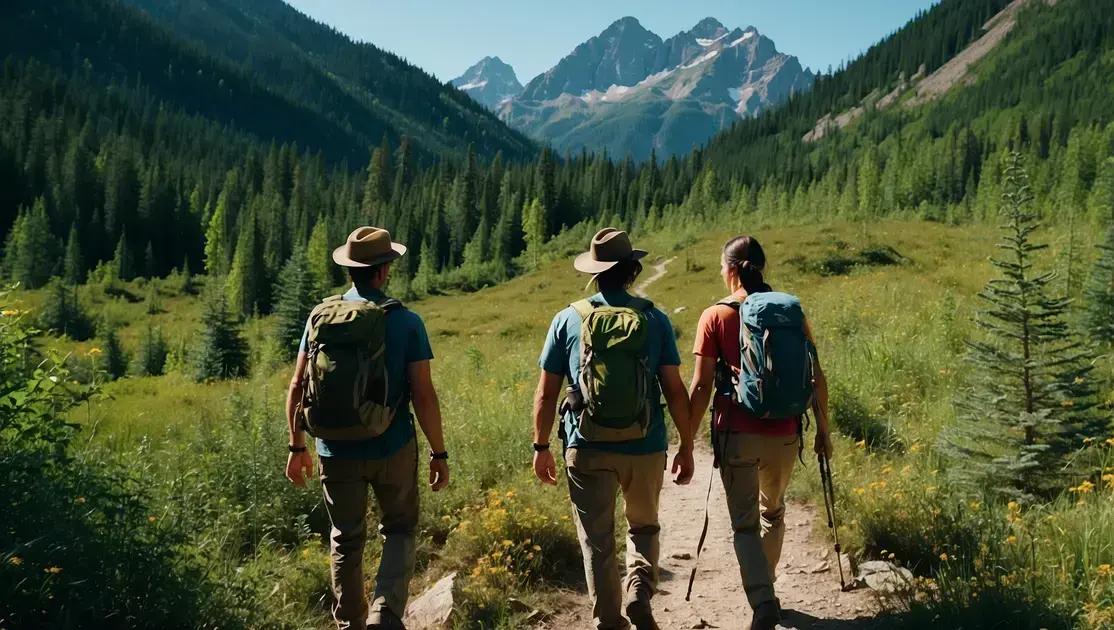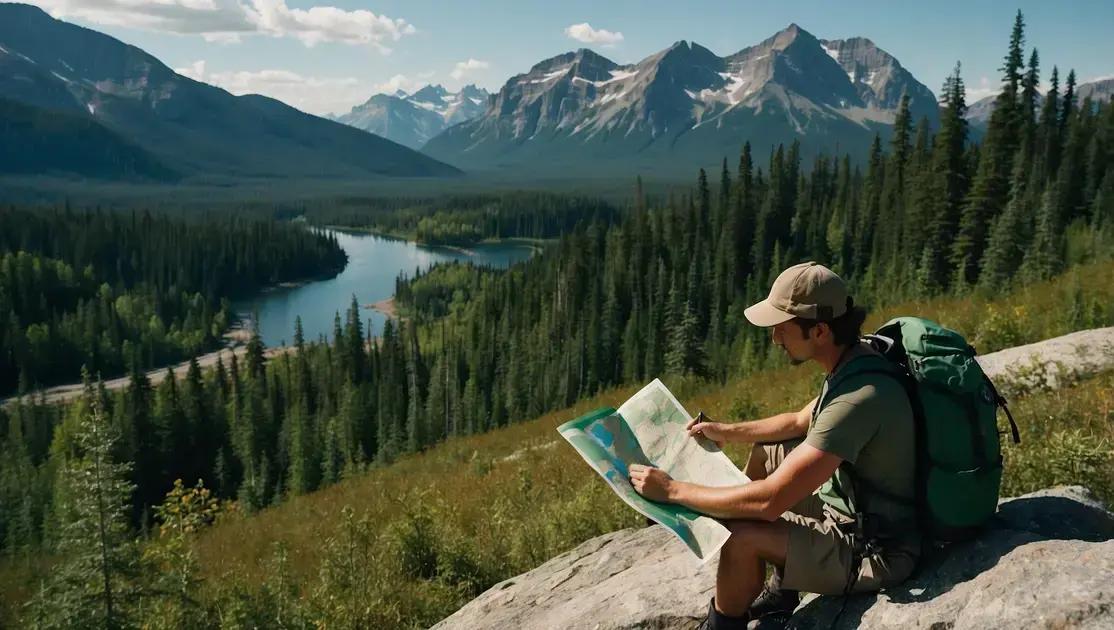The best hiking trails in Canada offer stunning landscapes and diverse experiences. Essential preparation includes the right gear, safety tips, and choosing trails suited to your skill level, ensuring an enjoyable and safe adventure in the great outdoors.
If you’re on the lookout for the **best hiking trails in Canada**, you’re in for a treat! From the lush forests of British Columbia to the rugged coastlines of Newfoundland, Canada is home to some of the most breathtaking hiking destinations in the world. In this article, we will unveil some of the absolute must-visit trails that not only offer stunning scenery but also a chance to connect with the great outdoors. Let’s lace up our hiking boots and prepare for an adventure!
Top 5 Hiking Trails in Canada
Canada is renowned for its breathtaking landscapes, making it a top destination for outdoor enthusiasts. Here are the top 5 hiking trails in Canada that showcase the country’s natural beauty and offer adventures for hikers of all skill levels.
1. West Coast Trail, British Columbia
The West Coast Trail is famous for its rugged coastline, lush rainforests, and diverse wildlife. Spanning 75 kilometers along Vancouver Island, this trail can take around 5-7 days to complete. Hikers can enjoy stunning views of the ocean, waterfalls, and tide pools, making it a truly memorable experience.
2. Banff National Park, Alberta
Banff National Park offers countless hiking opportunities, but the Plain of Six Glaciers trail is particularly popular. This 14-kilometer hike features breathtaking views of glaciers and Lake Victoria. The trail can be tackled in about 5-7 hours, and hikers are rewarded with spectacular viewpoints, especially at the historic tea house.
3. Grouse Grind, British Columbia
Known as “Mother Nature’s Stairmaster,” the Grouse Grind in North Vancouver is a challenging 2.9-kilometer trail that ascends steeply up Grouse Mountain. Hikers often complete it in about 1.5 to 2.5 hours. After reaching the top, you can enjoy panoramic views of the city and the surrounding mountains.
4. Cape Breton Highlands, Nova Scotia
The Cabot Trail includes the stunning Skyline Trail, a 7-kilometer loop that features dramatic cliffs and coastal views. The trail is well-maintained and offers a relatively easy hike, accessible for families. Keep an eye out for moose and eagles throughout your journey!
5. Mount Athos, Alberta
The hike to Mount Athos in Jasper National Park is an exhilarating experience. This challenging trail offers an 18-kilometer round trip, and skilled hikers can conquer it in 6-8 hours. The stunning views of the Athabasca Valley and surrounding lakes are worth the effort for any outdoor lover.
How to Choose the Best Hiking Trail

Choosing the best hiking trail can greatly enhance your outdoor experience. Here is a guide to help you select the perfect hike based on your preferences and skill level.
1. Assess Your Hiking Experience
Start by evaluating your hiking experience. Are you a beginner, intermediate, or advanced hiker? This will help you choose a trail that matches your skill level. For beginners, trails with well-marked paths and gentle inclines are ideal. More experienced hikers can seek out challenging terrain with varying elevation.
2. Consider Your Fitness Level
Your physical fitness plays a crucial role in trail selection. If you are new to hiking or have any health concerns, opt for shorter and easier trails. If you’re fit and enjoy the challenge, longer hikes with steep climbs may be more appealing.
3. Research Trail Conditions and Weather
Before deciding on a trail, check current conditions and weather forecasts. Research recent trail reports to understand if trails are open or if there are any hazards. Weather can affect trail conditions, so avoid hiking during extreme temperatures or storms.
4. Think About Scenery and Points of Interest
Different trails offer various scenic views and natural wonders. Consider what you’d like to see, whether it’s a beautiful lake, a unique rock formation, or a waterfall. Some trails may also provide opportunities for wildlife viewing or cultural experiences.
5. Plan Your Time and Distance
Be mindful of the time you have for your hike. Make sure to choose a trail that can be completed within your available time frame. Check the distance and estimated hiking time, and allow extra time for breaks and sightseeing along the way.
Essential Gear for Hiking in Canada
When hiking in Canada, having the right gear is essential for safety and comfort. The varied terrain and weather conditions mean you need to be prepared. Here’s a list of essential gear for hiking in Canada.
1. Proper Footwear
Your choice of footwear can make or break your hike. Invest in a good pair of hiking boots that provide ankle support and have a sturdy grip. Waterproof boots are recommended, especially for trails that may have streams or muddy patches.
2. Layered Clothing
Canada’s weather can change quickly, so wear layered clothing. Start with a moisture-wicking base layer, add an insulating layer like fleece, and finish with a waterproof and breathable outer layer. This way, you can adjust as needed to stay comfortable.
3. Backpack
A reliable backpack is a must-have for all hiking trips. Choose one that fits comfortably and offers enough space for your gear. Internal frames provide better support, while hydration packs are great for shorter hikes.
4. Navigation Tools
Bring navigation tools such as a map, compass, or a GPS device. Knowing how to read a map is essential, even if you have GPS, as technology can sometimes fail. A portable charger for your devices is also a smart addition.
5. Hydration System
Staying hydrated is crucial during hikes. Carry enough water with you, either in bottles or a hydration bladder. It’s often recommended to drink water regularly, even if you do not feel thirsty.
6. First Aid Kit
Accidents can happen anytime, so having a first aid kit is vital. Make sure it includes items like band-aids, antiseptic wipes, pain relievers, and any personal medication. Familiarize yourself with how to use the items in your kit before heading out.
7. Emergency Gear
Always pack emergency gear, including a whistle, mirror, and a space blanket. These items can be invaluable if you find yourself in a critical situation. A multi-tool can also serve various needs on the trail.
Safety Tips for Exploring Canadian Wilderness

Exploring the Canadian wilderness can be an incredible adventure, but safety should always be your top priority. Here are some essential tips for staying safe while hiking in Canada’s great outdoors.
1. Plan Your Route
Before heading out, always plan your route and share it with someone. Know the trail details, estimated times, and any potential hazards. Carry a detailed map and familiarize yourself with landmarks.
2. Stay Aware of Weather Conditions
Weather in Canada can change rapidly, so check forecasts before your hike. Be prepared for rain, snow, or sudden temperature drops. Dress in layers and carry rain gear to adjust to sudden weather changes.
3. Hike with a Partner
It’s safer to hike with a partner or group. Sharing the experience not only enhances enjoyment but also provides help in case of emergencies. If hiking alone, make sure someone knows your itinerary.
4. Carry the Ten Essentials
Always pack the ten essentials for hiking: navigation tools, a first aid kit, extra food and water, fire-starting tools, a knife, emergency shelter, and layered clothing. These items can be vital in emergencies.
5. Watch for Wildlife
Canada is home to diverse wildlife, including bears and moose. Familiarize yourself with safety tips for wildlife encounters. Make noise while hiking to avoid surprising animals and carry bear spray in bear country.
6. Be Cautious Near Water
Many hikes can involve rivers and lakes. Always be careful around water, as currents can be strong and banks can be slippery. Never cross rivers on foot unless you are sure it’s safe.
7. Know Your Limits
It’s important to recognize your physical limits. Choose trails appropriate for your skill and fitness levels. If you’re tired or unsure, don’t hesitate to turn back.
Enjoy Your Hiking Adventure in Canada
Canada offers some of the most stunning hiking trails and natural beauty in the world. By preparing properly, staying safe, and choosing the right trails, you can ensure an enjoyable experience. Remember to invest in quality gear, plan your routes, and respect the wilderness.
Whether you are hiking with friends or exploring solo, these tips will help you make the most of your adventure. Embrace the beauty of the Canadian outdoors and create unforgettable memories while hiking.
So lace up your boots, pack your essentials, and get ready to explore the breathtaking landscapes of Canada!


